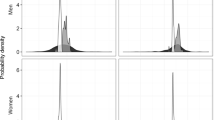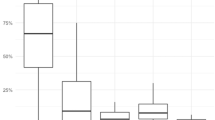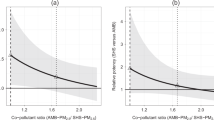Abstract
Volunteer studies suggest that showering/bathing with chlorinated tap water contributes to daily chloroform inhalation exposure for the majority of US adults. We used data from the 1999–2000 US National Health and Nutrition Examination Survey (NHANES) and weighted multiple linear regression to test the hypothesis that personal exposure microevents such as showering or spending time at a swimming pool would be significantly associated with chloroform levels in 2–3 day personal air samples. The NHANES data show that eight of 10 US adults are exposed to detectable levels of chloroform. Median (1.13 μg/m3), upper percentile (95th, 12.05 μg/m3), and cancer risk estimates were similar to those from recent US regional studies. Significant predictors of log personal air chloroform in our model (R2=0.34) included age, chloroform concentrations in home tap water, having no windows open at home during the sampling period, visiting a swimming pool during the sampling period, living in a mobile home/trailer or apartment versus living in a single family (detached) home, and being Non-Hispanic Black versus Non-Hispanic White, although the race/ethnicity estimates appear influenced by several outlying observations. Reported showering activity was not a significant predictor of personal air chloroform, possibly due to the wording of the NHANES shower question. The NHANES measurements likely underestimate true inhalation exposures since subjects did not wear sampling badges while showering or swimming, and because of potential undersampling by the passive monitors. Research is needed to quantify the potential difference.
This is a preview of subscription content, access via your institution
Access options
Subscribe to this journal
Receive 6 print issues and online access
$259.00 per year
only $43.17 per issue
Buy this article
- Purchase on Springer Link
- Instant access to full article PDF
Prices may be subject to local taxes which are calculated during checkout

Similar content being viewed by others
Abbreviations
- AER:
-
air exchange rate
- CalEPA:
-
California Environmental Protection Agency
- CDC:
-
US Centers for Disease Control and Prevention
- CI:
-
confidence interval
- DHHS:
-
US Department of Health and Human Services
- NHANES:
-
US National Health and Nutrition Examination Survey
- RfD:
-
reference dose
- TEAM:
-
Total Exposure Assessment Methodology
- EPA:
-
US Environmental Protection Agency
References
Backer L.C., Ashley D., Bonin M.A., Cardinali F.L., Kieszak S.M., and Wooten J.V. Household exposures to drinking water disinfection by-products: whole blood trihalomethane levels. J Expo Anal Environ Epidemiol 2000: 10: 321–326.
CalEPA (California Environmental Protection Agency). Air Toxics Hot Spots Program Risk Assessment Guidelines. Part II. California EPA, Sacramento, 2002.
Caro J., and Gallego M. Assessment of exposure of workers and swimmers to trihalomethanes in an indoor swimming pool. Environ Sci Technol 2007: 41: 4793–4798.
CDC. NHANES 1999–2000 Addendum to the NHANES III Analytic Guidelines. DHHS, CDC, Hyattsville, MD, 2002.
CDC. NHANES Data (1999–2000). DHHS, CDC, Hyattsville, MD, 2005a.
CDC. NHANES 1999–2000 Family-Demographic Questionnaire. DHHS, CDC, Hyattsville, MD, 2005b.
CDC. NHANES 1999–2000 Family-Housing Characteristics Questionnaire. DHHS, CDC, Hyattsville, MD, 2005c.
CDC. NHANES Data (1999–2000)-Medical Examination. DHHS, CDC, Hyattsville, MD, 2005d.
CDC. NHANES Data (1999–2000)-Demographics. DHHS, CDC, Hyattsville, MD, 2005e.
CDC. NHANES Data (1999–2000)-Questionnaire. DHHS, CDC, Hyattsville, MD, 2005f.
CDC. Analytical and Reporting Guidelines, NHANES. DHHS, CDC, Hyattsville, MD, 2006.
CENTERS FOR DISEASE CONTROL AND PREVENTION (CDC). NHANES Data (1999–2000)—Lab 04. Department of Health and Human Services (DHHS), CDC, Hyattsville, MD, 2007a.
CDC. NHANES Data (1999–2000)—Lab 21. DHHS, CDC, Hyattsville, MD, 2007b.
CDC. NHANES Laboratory Procedures Manual,. DHHS, CDC, Hyattsville, MD, 2001.
Census Bureau. Census 2000—Population by Race and Hispanic or Latino Origin for the United States. US Census Bureau, Washington, DC, 2000.
Chung C.W., Morandi M.T., Stock T.H., and Afshar M. Evaluation of a passive sampler for volatile organic compounds at ppb concentrations, varying temperatures, and humidities with 24-h exposures 2. Sampler performance. Environ Sci Technol 1999: 33 (20): 3666–3671.
Clayton C.A., Pellizzari E., Whitmore R.W., Perritt R.L., and Quackenboss J.J. National human exposure assessment survey (NHEXAS): distributions and associations of lead, arsenic and volatile organic compounds in EPA region 5. J Expo Anal Environ Epidemiol 1999: 9: 381–392.
DHHS, Public Health Service. Report on Carcinogens, 11th edn. National Toxicology Program, Washington, DC, 2005.
EPA. Residual Risk: Report to Congress. EPA-453/R-99-001. EPA Office of Air Quality Planning and Standards, Research Triangle Park, NC, 1999.
EPA. Toxicological Review of Chloroform. EPA/635/R-01/001. EPA, Washington, DC, 2001a.
EPA. TRI 1999 Data Release. EPA, Washington, DC, 2001b.
EPA. TRI 2000 Data Release. EPA, Washington, DC, 2002.
EPA. Guidelines for Carcinogen Risk Assessment. EPA/630/P-03/001F. EPA, Washington, DC, 2005.
EPA (US Environmental Protection Agency). Integrated Risk Information System—Chloroform. EPA, Washington, DC, 2007.
Erdinger L., Kühn K.P., Kirsch F., Feldhues R., Fröbel T., and Nohynek B., et al. Pathways of trihalomethane uptake in swimming pools. Int J Hyg Environ Health 2004: 207: 571–575.
Fantuzzi G., Righi E., Predieri G., Ceppelli G., Gobba F., and Aggazzotti G. Occupational exposure to trihalomethanes in indoor swimming pools. Sci Tot Environ 2001: 264: 257–265.
Gordon S.M., Brinkman M., Ashley D.L., Blount B.C., Lyu C., and Masters J., et al. Changes in breath trihalomethane levels resulting from household water-use activities. Environ Health Perspect 2006: 114: 514–521.
Keene W.C., Khalil M.A.K., Erikson III D.J., McCulloch A., Graedel T.E., and Lobert J.M., et al. Composite global emissions of reactive chlorine from anthropogenic and natural sources. J Geophys Res 1999: 104: 8429–8440.
Kerger B.D., Schmidt C., and Paustenbach D.J. Assessment of airborne exposure to trihalomethanes from tap water in residential showers and baths. Risk Anal 2000: 20: 637–651.
Korn E.L., and Graubard B.I. Scatterplots with survey data. Am Stat 1998: 52: 58–69.
Krasner S.W., and Wright J.M. The effect of boiling water on disinfection by-product exposure. Water Res 2005: 39: 855–864.
Lévesque B., Ayotte P., Tardif R., Charest-Tardif G., Dewailly E., and Prud’Homme D., et al. Evaluation of the health risk associated with exposure to chloroform in indoor swimming pools. J Toxicol Environ Health A 2000: 61: 225–243.
Lide D.R., (ed). Handbook of Chemistry and Physics, 77th edn. CRC Press, Boca Raton, 1996.
Lindstrom A.B., Pleil J., and Berkoff D.C. Alveolar breath sampling and analysis to assess trihalomethane exposures during competitive swimming training. Environ Health Perspect 1997: 105: 636–642.
Loh M.M., Levy J.I., Spengler J.D., Houseman E.A., and Bennett D.H. Ranking cancer risks of organic hazardous air pollutants in the United States. Environ Health Perspect 2007: 115: 1160–1168.
Lynberg M., Nuckols J., Langlois P., Ashley D., Singer P., and Mendola P., et al. Assessing exposure to disinfection by-products in women of reproductive age living in Corpus Christi, Texas, and Cobb County, Georgia. Environ Health Perspect 2001: 109: 597–604.
McCulloch A. Chloroform in the environment: occurrence, sources, sinks and effects. Chemosphere 2003: 50: 1291–1308.
McKone T.E. Human exposure to volatile organic compounds in household tap water: the indoor inhalation pathway. Environ Sci Tech 1987: 21: 1194–1201.
Nieuwenhuijsen M.J., Toledano M., and Elliott P. Uptake of chlorination disinfection by-products: review. J Expo Anal Environ Epidemiol 2000: 10: 586–599.
Nuckols J.R., Ashley D.L., Lyu C., Gordon S.M., Hinckley A.F., and Singer P. Influence of tap water quality and household water use activities on indoor air and internal dose levels of trihalomethanes. Environ Health Perspect 2005: 113: 863–870.
Payne-Sturges D.C., Burke T.A., Breysse P., Diener-West M., and Buckley T.J. Personal exposure meets risk assessment: comparison of measured and modeled exposures and risks in an urban community. Environ Health Perspect 2004: 112: 589–598.
Pellizzari E.D., Perritt R.L., and Clayton C.A. National human exposure assessment survey (NHEXAS): exploratory survey of exposure among population subgroups in EPA Region V. J Expo Anal Environ Epidemiol 1999: 9: 49–55.
Pellizzari E.D., Smith D.J., Clayton C.A., Michael L.C., and Quackenboss J.J. An assessment of the data quality for NHEXAS-Part I: exposure to metals and volatile organic chemicals in Region 5. J Expo Anal Environ Epidemiol 2001: 11: 140–154.
Pratt G.C., Bock D., Stock T.H., Morandi M., Adgate J.L., and Ramachandran G., et al. A field comparison of volatile organic compound measurements using passive organic vapor monitors and stainless steel canisters. Environ Sci Technol 2005: 39 (9): 3261–3268.
Research Triangle Institute. SUDAAN User's Manual, Release 8.0. Research Triangle Institute, Research Triangle Park, NC, 2001.
Sax S.N., Bennett D.H., Chillrud S.N., Kinney P.L., and Spengler J.D. Differences in source emission rates of volatile organic compounds in inner-city residences of New York City and Los Angeles. J Expo Anal Environ Epidemiol 2004: 14 (Suppl 1): S95–109.
Sax S.N., Bennett D.H., Chillrud S.N., Ross J., Kinney P.L., and Spengler J.D. A cancer risk assessment of inner-city teenagers living in New York City and Los Angeles. Environ Health Perspect 2006: 114: 1558–1566.
Sexton K., Adgate J.L., Mongin S.J., Pratt G.C., Ramachandran G., Stock T.H., and Morandi M.T. Evaluating differences between measured personal exposures to volatile organic compounds and concentrations in outdoor and indoor air. Environ Sci Technol 2004b: 38 (9): 2593–2602.
Sexton K., Adgate J.L., Ramachandran G., Pratt G.C., Mongin S.J., Stock T.H., and Morandi M.T. Comparison of personal, indoor, and outdoor exposures to hazardous air pollutants in three urban communities. Environ Sci Technol 2004a: 38: 423–430.
Wallace L. Human exposure to volatile organic pollutants: implications for indoor air studies. Annu Rev Energy Environ 2001: 26: 269–301.
Wallace L.A. Comparison of risks from outdoor and indoor exposure to toxic chemicals. Environ Health Perspect 1991: 95: 7–13.
Wallace L.A. The Total Exposure Assessment Methodology (TEAM) Study: Summary and Analysis: Volume I. EPA Office of Research and Development, Washington, DC, 1987.
Weisel C.P., Kim H., Haltmeier P., and Klotz J.B. Exposure estimates to disinfection by-products of chlorinated drinking water. Environ Health Perspect 1999: 107: 103–110.
Weisel C.P., Zhang J., Turpin B.J., Morandi M.T., Colome S., Stock T.H., and Spektor D.M., et al. Relationships of Indoor, Outdoor, and Personal Air (RIOPA): Part I. Collection Methods and Descriptive Analyses. Mickey Leland National Urban Air Toxics Research Center, Houston, TX, 2005.
Weisel C.P., and Chen W.J. Exposure to chlorination by-products from hot water uses. Risk Anal 1994: 14: 101–106.
Xu X., and Weisel C.P. Human respiratory uptake of chloroform and haloketones during showering. J Expo Anal Environ Epidemiol 2005: 15: 6–16.
Acknowledgements
Supported by Grant number 2006-01 of the Mickey Leland National Urban Air Toxics Research Center (NUATRC). Ideas expressed are the authors’ and not necessarily those of NUATRC. All authors have disclosed that there exist no potential conflicts of interest regarding this manuscript.
Author information
Authors and Affiliations
Corresponding author
Additional information
The present work was performed at the Department of Environmental and Occupational Health, Rollins School of Public Health, Emory University.
Rights and permissions
About this article
Cite this article
Riederer, A., Bartell, S. & Ryan, P. Predictors of personal air concentrations of chloroform among US adults in NHANES 1999–2000. J Expo Sci Environ Epidemiol 19, 248–259 (2009). https://doi.org/10.1038/jes.2008.7
Received:
Accepted:
Published:
Issue Date:
DOI: https://doi.org/10.1038/jes.2008.7
Keywords
This article is cited by
-
Coupling external with internal exposure metrics of trihalomethanes in young females from Kuwait and Cyprus
Journal of Exposure Science & Environmental Epidemiology (2018)



